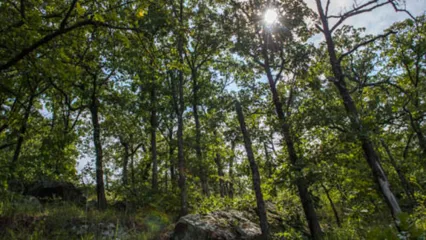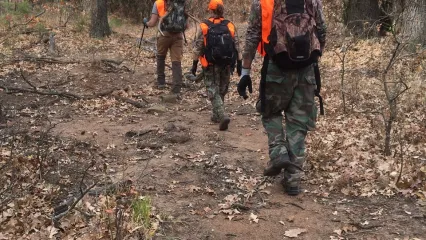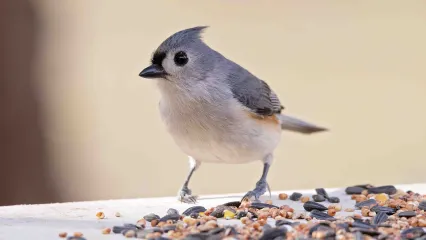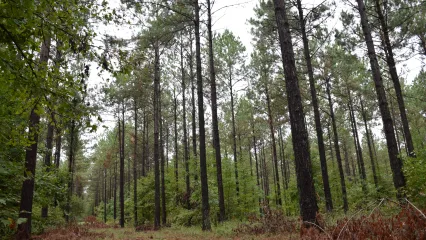Attention Non-Residents
The Oklahoma Wildlife Conservation Commission adopted new rules in 2025 that require non-residents accessing certain Oklahoma public hunting and fishing areas to check in and out of the area. By checking in and out of these areas, hunters, anglers, shooters, birdwatchers, hikers and any other users can help the Wildlife Department better understand how the area is being used. There is no additional cost associated with checking in or out of an area. There is no limit to the number of check ins for an individual in a year.

Contacts
Area Details
Okmulgee PHA covers 2,940 acres of west-central Okmulgee County. It is part of the Okmulgee WMA, which also includes the Okmulgee GMA. Located 5 miles west of the city of Okmulgee, the area is heavily wooded in post oak-blackjack timber and bisected by seven miles of the Deep Fork of the Canadian River. The Okmulgee Wildlife Management Area contains one of the largest known tracts of old growth Post oak/Blackjack oak "Crosstimbers" found anywhere. Many of the area's post oaks are likely over 350 years old, making them some of the oldest trees found East of the Rocky Mountains in North America. Crosstimber, although not highly productive, is unique in that it provides habitat for both classic "Western" species like the Greater Roadrunners and Easter species like the Indigo Bunting and is rich in biological diversity.
The area is approximately 95% wooded, with elevations ranging from about 600 ft. near the river to over 950 ft. on wooded ridges. Post oaks, blackjack oaks, and hickories dominate the poor, rocky upland soils, with burr oaks, pin oaks, red oaks and sycamores dominating the riparian bottomland. The average annual rainfall is 42 inches.
Shooting Range (Located on the GMA Portion of the are)
From Okmulgee: From U.S. Hwy 75, 7.9 miles west on State Hwy 56 to entrance on right.
Entrance #2
From Okmulgee: From State Hwy 56, 4 miles north on U.S. Hwy 75, 3 miles west on Celia Berryhill Road to entrance on left.
Entrance #3
From Okmulgee: From State Hwy 56, 4 miles north on U.S. Hwy 75, 5 miles west on Celia Berryhill Road (always keep left) to entrance on left.
Entrance #4
From Beggs: 1.4 miles south on U.S. Hwy 75 ALT, right on Webster Rd, 4.2 miles south on Webster Rd to entrance on right.
- Quail: Bobwhite quail present in low numbers.
- Deer: White-tailed deer are present in good numbers but are highly sought after.
- Turkey: Turkeys are present in fair numbers but are highly sought after.
- Rabbit: Cottontails and swamp rabbits are present in good numbers but swamp rabbits are highly sought after.
- Furbearers: Bobcat, coyote and raccoon are abundant.
- Dove: Present in low numbers.
- Waterfowl: Waterfowl are abundant when conditions are favorable, primarily mallard, wood duck, and teal. This area rarely holds geese.
- Squirrel: Both gray and fox squirrel are abundant.
- Bald Eagle: Infrequently seen in both summer and winter months.
- Warblers: The mature bottomland hardwoods are frequented by several species of warblers uncommon elsewhere.
Approximately fifteen hundred acres are targeted for prescribed burning annually. Wildlife plots are planted to cool season annuals and permanent clover pastures. Old fields are mowed as needed to control succession in small clearings. Waterfowl units are manipulated with water level controls and annual discing as necessary.
A primitive camping area is located just inside Entrance #4 on the Public Hunting Area and Okmulgee State Park is located just one half mile east of the main entrance to the Game Management Area on highway 56.
Both a 100 and 200 yard shooting range is located on highway 56, one mile west of the Game Management Area entrance #1.
Fishing opportunities exist at several area ponds, but the area is most famous for its huge flathead catfish that occasionally are wrestled from the Deep Fork River, accesses are open seasonally. Also nearby Okmulgee Lake and Dripping Springs Lake offer good fishing for largemouth bass and other species (i.e. crappie, channel catfish, and sunfish).
All shotgun hunting is restricted to federally approved nontoxic shot on the WDU portion.
Same As Statewide Seasons
Seasons w/ Special Restrictions
- Deer Gun
Closed to antlerless hunting.
- Quail, Dove, Rail, Gallinule, Snipe, Squirrel, Woodcock, Rabbit, Pursuit with Hounds for Furbearers, Predator/Furbearer Calling, Trapping
Closed from the opening day of deer archery season through the first nine days of deer gun season.
- Turkey Fall Gun
Tom only, shotgun only.
- Crow
Open Dec. 9 - March 4.
- Duck, Merganser and Coot
Hunting hours for waterfowl close at 1 p.m. daily on the WDU portion.
- Turkey Spring, Youth Turkey Spring
One-tom limit; seasons combined.
Closed to all nonhunting activities, except hunter camping, from Oct. 1 - Feb. 15.
Hunter and angler camping is allowed in designated areas.
Q: Is the gun range open?
A: Yes, the gun range is open daily from official sunrise to 30 minutes after official sunset. The gun range does not close during controlled hunts.
Q: What is the difference between Okmulgee PHA and Okmulgee GMA?
A: Okmulgee PHA and GMA are both part of the Okmulgee WMA (Wildlife Management Area). The PHA (Public Hunting Area) and GMA (Game Management Area) designations indicate differing management strategies. See below:
PHA - Areas where most forms of wildlife harvest are permitted by statewide hunting, fishing, and furbearer regulations. Some area-specific regulations may indicate otherwise. Example: Deer gun season is open on Okmulgee PHA, but antlerless harvest is not allowed for that season.
GMA - Areas where hunting and public use are more closely regulated than on PHA’s. Example: Deer gun season is closed on Okmulgee GMA except for controlled hunts.
Q: Can I hunt hogs on Okmulgee WMA
A: Yes, hogs may be taken on Okmulgee WMA during any established hunting season with methods authorized by the Department for that hunting season, except that during any open deer and/ or turkey season, only appropriate methods, hunting hours, and legal equipment for that deer and/or turkey season are authorized for taking or pursuing feral hogs. No feral hogs may be removed alive from a WMA.
Pursuit of hogs with hounds is prohibited during the deer and turkey seasons on department-managed lands. Pursuit of hogs at night is prohibited from Oct. 1 - Jan. 15 and during any spring turkey season. Pursuit of hogs at night during any other time of the year has the following restrictions: Use of a firearm is prohibited. In addition, persons pursuing hogs must comply with all other WMA regulations.
Resident & Nonresident License Requirements: All persons pursuing hogs must possess a hunting license, unless otherwise exempt. In addition, persons pursuing hogs on WMAs open during youth deer gun, bear muzzleloader (in open counties), deer muzzleloader, deer gun, Holiday Antlerless Deer Gun (in open zones), elk gun (in open counties) and antelope gun (in open areas) seasons with a shotgun and rifled slug, or any rifle or handgun larger than .22 caliber rimfire, must possess either a filled or unfilled license appropriate for the current season, unless otherwise exempt.
Apprentice Designation: A Learner's Permit for Hunting
Hunter education has greatly reduced hunting accidents, but if you can’t complete a course right away, the apprentice designation allows you to hunt under supervision. It works like a learner’s permit, giving you the chance to gain real experience safely until you finish hunter education.
Exploring the New Herron Family WMA
The new Herron Family WMA is more than 17,000 acres of hunting land, it is also adventure, access, conservation, and tradition. Thanks to a unique partnership, Oklahoma residents now have a new place to chase deer, call turkeys, hear quail, and pass on the outdoors to the next generation.



